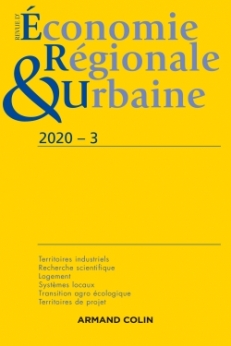
Revue d'économie régionale et urbaine (3/2020)
Pour acheter ce numéro, contactez-nous
Recevez les numéros de l'année en cours et accédez à l'intégralité des articles en ligne.
Cet article apporte des éléments d’éclairage sur les liens entre science et développement territorial. Pour un territoire, en particulier métropolitain, une stratégie de développement économique incluant les activités scientifiques passe par deux objectifs : un objectif de rayonnement scientifique international (RSI), et un objectif de fertilisation locale (FL). Après un examen des différentes combinaisons RSI-FL envisageables, nous testons empiriquement l’une des configurations identifiées, la coexistence RSI-FL, à partir d’un double cas d’étude : celui des sites de Brest (France) et Bergen (Norvège) dans le domaine des sciences marines. Trois méthodes sont mises en oeuvre successivement : deux méthodes mixtes comparatives (bibliométrie spatialisée et enquête par entretiens) et une modélisation input-output régionalisée. Les différents résultats sont mis en perspective afin d’estimer dans quelle mesure le RSI peut exister et se développer tout en nourrissant la FL, et quelles en sont les conditions favorables, ou à l’inverse les freins.
This paper examines the links between scientific activities and territorial development. For a territory, particularly a metropolitan area, an economic development strategy including scientific activities focuses on two objectives: on the one hand, international scientific networking (ISN), and on the other hand, local fertilization (LF). After reviewing of the different potential ISN-LF combinations, we empirically test one specific configuration, the ISN-LF coexistence. The analysis is based on a double case study, both thematic and geographical: the Brest (France) and Bergen (Norway) sites in the field of marine sciences. Three methods are successively implemented: two combined and comparative methods (spatialized bibliometrics and interview survey) and a regionalized input-output modelling. The different results are contrasted in order to appreciate how ISN can exist and develop while strengthening the LF dynamics, and to identify the nurturing conditions, or conversely the drags. Several conclusions are drawn: first, the ISN-LF articulation scheme appears to be different in the two territories studied, despite a similar ISN performance. Secondly, the significant and actual performing of an ISN-LF coexistence scheme where ISN strengthens the LF (Bergen case) seems to be a stabilizing factor, or even improving factor for the ISN performance, and not a deteriorating factor. Recommendations are suggested: relying on the effectiveness of incentive funding mechanisms for researchers and firms; acting firstly on future researchers, by learning, in order to increase the propensity to collaborate and to develop a common collaborative culture; the need for a stronger presence of transfer organizations within the local scientific community; and finally the need for a matching and an intentional adaptation of the research and innovation policies to the main local economic sectors.
